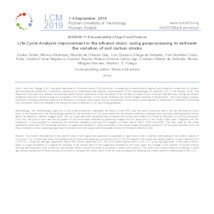Life cycle analysis improvement in the ethanol chain: using geoprocessing to estimate the variation of soil carbon stocks.
Life cycle analysis improvement in the ethanol chain: using geoprocessing to estimate the variation of soil carbon stocks.
Author(s): SODRÉ, C. A. S.; ALCANTARA, M. H. de M.; DIAS, R. de O.; ORTEGA, L. G.; KABE, Y. O.; NOGUEIRA, S. F.; SILVA, G. B. S. da; LIGO, M. A. V.; ANDRADE, C. A. de; NOVAES, R. M. L.; MATSUURA, M. I. da S. F.
Summary: Abstract: Land Use Change (LUC) has great relevance for Brazilian overall CO2 emissions. Considering its relationship to agricultural production, especially for biofuels and biomaterials production, it becomes paramount to understand and replicate improvements on the methodologies to measure LUC in the ethanol chain. The objective of this work is to reduce uncertainties and to ensure traceability in the calculation of the variation of carbon stock in the soil and Biomass, during the ethanol production process in Brazil aiming at a complete LCA of the product. In this sense, Braskem, the world\s largest producer of biopolymers, Atvos the largest supplier of ethanol, Embrapa (Brazilian Agricultural Research Company) and Quantis (Swiss sustainability consultancy) joined together to experiment a method of estimating LUC emissions, which will feedback the process to help to develop a LUC accounting guidance.
Publication year: 2019
Types of publication: Abstract in annals or event proceedings
Unit: Embrapa Environment
Observation
Some of Embrapa's publications are published as ePub files. To read them, use or download one of the following free software options to your computer or mobile device. Android: Google Play Books; IOS: iBooks; Windows and Linux: Calibre.
Access other publications
Access the Agricultural Research Database (BDPA) to consult Embrapa's full library collection and records.
Visit Embrapa Bookstore to purchase books and other publications sold by Embrapa.

